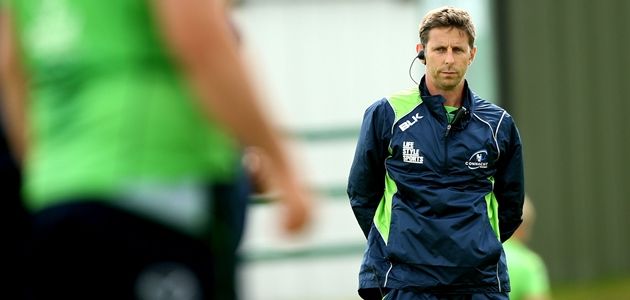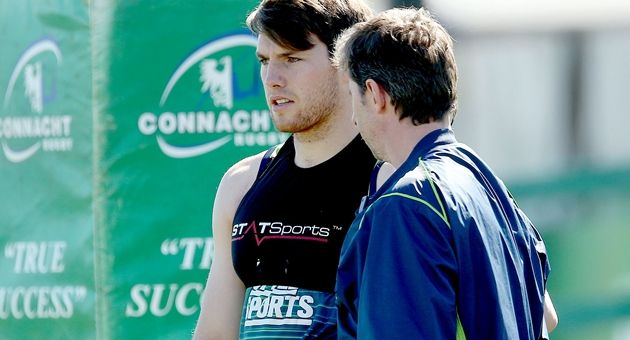Sizeable gains out west.
Connacht Rugby may be outsiders for a Champions Cup spot, heading into the final two games of the Guinness PRO12, but Paul Bunce still calls it an incredible season.
The western province set its sights on qualifying for Europe’s elite competition under their own steam. They occupied a top four spot in the early months and defeated Leinster and Munster at The Sportsground. Form is beginning to waiver but finishing the season with two wins may be enough to return to Europe’s top table.
One of the noticeable changes at Connacht this season has been the improved fitness of players and, in the words of former hooker Adrian Flavin, lads putting on timber. That, in larger part, is down to Connacht’s Head of Fitness, Paul Bunce.
‘Like every Kiwi,’ he says, ‘I love the game and played with a club side in Wellington. I was an okay fullback and a poor fly-half.’ He kept up his involvement in rugby after obtaining a sports science degree.
Bunce began his journey in Super 10 [now Super Rugby] with Wellington Hurricanes. His first posting in Europe was with Newport Gwent Dragons before he spent four and a half seasons with Bath. His posting, before Connacht tempted him to Galway, was with the Scottish Rugby Union, primarily looking after the Men’s Sevens side.
Strength and conditioning, he believes, has improved rugby and helped produce better athletes. He sees his main jobs as monitoring strength, body weight, power expression, body composition [muscle to fat ratio], power and readiness to train and play.
‘We want players to be hands-on. They should have a say in their fitness routines and diet plans,’ he says.
Having met up with Connacht head coach Pat Lam, Bunce set himself achievable goals and broke them into seasons. He comments, ‘There were good levels of fitness when I first arrived but the game does not allow for the fittest teams to always be the most successful.
‘On a rainy, wet, cold night, teams can be camped on your tryline for 10 minutes. It’s the grind; strength and power that will win the battle.’
Bunce adds, ‘The first goal is to improve strength. Everyone else is getting big and strong so we need to, too.
‘Focusing on, and growing, lean muscle tissue was a priority. Most [Connacht] guys needed to put on size and muscle… One of our players has put on 16 kilograms [two and a half stone] this season. Many of the younger players are still going through that growing process.
‘We are building physical sepecimens. That has led to a lot more physical preparation [this season].’
Bunce insists that the increase in bulk, muscle and body size has not led to fitness or performance levels dropping off.
And how does a club go about increasing size, strength, muscle mass and power?
‘We get them into the gym two or three times a week. We work out a needs analysis and work out individual programmes for players.
‘One big improvement at Connacht has been that we now get a performance nutritionist coming in to us twice a week. It lets the guys know about what they eat, how they do it, the benefits. It has helped to create a behavioural change.’
Another, obvious, way for a player to increase his size is to increase his calorie intake. While the average Irish male will have 2,500 calories a day, rugby players, on average, will have about 3,500. Certain players, in certain positions, may be closer to the 4,000 mark. The diets would, generally, be high in protein.
The sessions are fulsome so the calories, and the energy they provide, are crucial. During a regular season, players at Connacht have three S&C sessions – focusing on speed, power, development – eight rugby sessions [including warm-up and cool-down], as well as injury rehab and prevention sessions.
Key parameters and statistics
A current obsession with football analysts and pundits, ever since GPS units were installed in jerseys, has been kilometres covered per match. Elite footballers will regularly bypass 9km per game, with many midfielders covering 10, 11km and beyond.
Rugby is often a game played in fits and starts, around set-pieces, so the same amount of ground will not be covered. Bunce says a front-row will usually cover 5-5.5km per match. A player in the backline, in a match of high intensity running, can reach 7-7.5km.
One of the key parameters tracked by clubs, and countries, is now metres-per-minute. This allows coaches to see how a player is coping with the pace of a game once the ball is in motion.
‘The Ireland team train for worst-case scenarios,’ says Bunce. ‘They will often have the ball kept in play for four-minute blocks to see how the players can cope with long periods of repeated high intensity, and the situation.’
Ireland had previously ran two-minute, non-stop attacking drills. That was increased to 3:20 after England beat Ireland in 2014. Ahead of the World Cup, Schmidt is now running his players extremely hard for four minutes – it was a decision taken on the back of viewing a breath-taking South Africa v New Zealand Rugby Championship encounter.
Closer to home, Bunce says similar drills would take place, along with other, regular, and player-specific sessions. ‘The players have worked their butts off this year.’
As for the toughest games Connacht have played this season, Bunce points to two games that involved maximum effort and application but unfortunate, close defeats.
The Gloucester [Challenge Cup quarter final] game was intense,’ says Bunce, ‘and the Cardiff game, away. That had eight or nine minutes of over-time and the players were pushed to the Nth degree.
‘The Munster and Leinster games at home, too, were huge for the players. Thankfully, on those days, all the hard work paid off.’






























